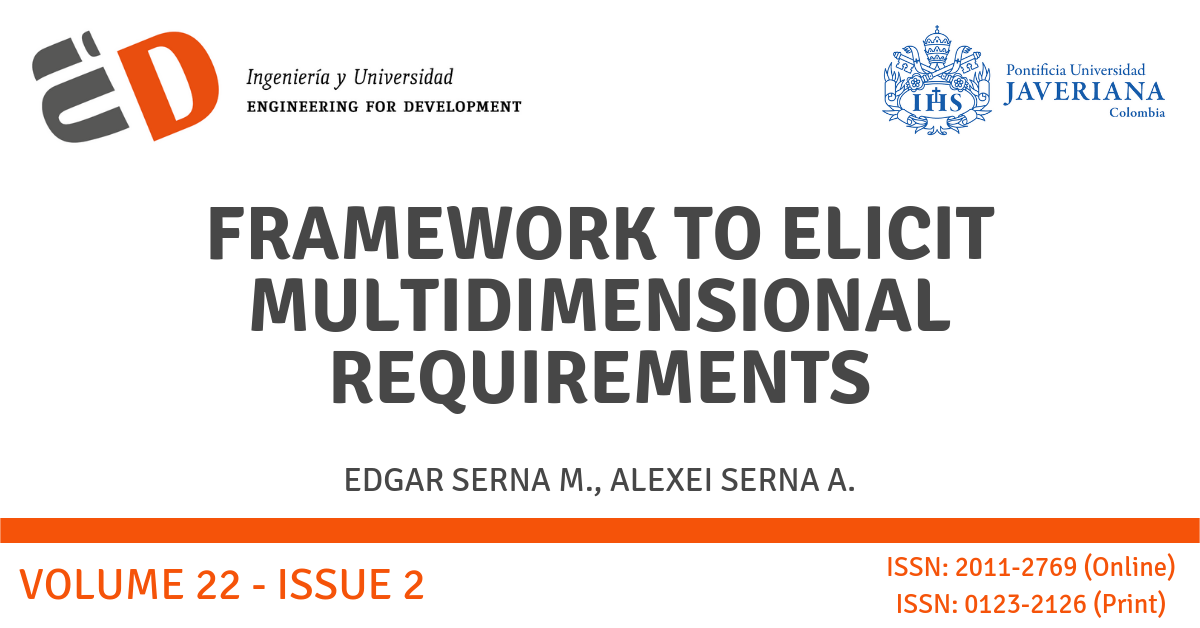Framework to elicit multidimensional requirements

##plugins.themes.bootstrap3.article.details##
Objective: Propose a framework to elicit multidimensional requirements. Materials and methods: A review of the literature is carried out, and the elicitation proposals are analyzed in which the multidimensionality of the requirements is taken into account. Results and discussion: 23 works were found, of which 15 were selected that met the quality conditions and inclusion criteria. These proposals are related to multidimensionality in elicitation but do not take it into account in order to construct a representative requirement specification. Conclusion: It is evident that there is no unanimity about the dimensions from which the requirements originate, and they have not been elicited. For this reason, and because its existence is accepted, it is necessary to unify criteria and propose frameworks to elicit multidimensional requirements.
Requirements Elicitation, Software Engineering, Software Requirements, MultidimensionalityElicitación de requisitos, Ingeniería del software, Ingeniería de requisitos, Multidimensionalidad
[2] A. Alvear and G. Quintero, “Integrating software development techniques, usability, and agile methodologies,” Actas, vol. 1, pp. 94-103, 2015. [Online]. Available: http://fundacioniai.org/actas/Actas1/Actas%201.15.pdf
[3] K. Pohl, “The three dimensions of requirements engineering: A framework and its applications,” Inform. Syst., vol. 19, no. 3, pp. 243-258, 1994. [Online]. Available: https://doi.org/10.1016/0306-4379(94)90044-2
[4] A. Durán, “Un entorno metodológico de Ingeniería de Requisitos para Sistemas de Información,” Ph.D dissertation, Dep. Leng. Sist. Info., Univ. Sevilla, España, 2000. [Online]. Available: http://fondosdigitales.us.es/tesis/tesis/30/un-entorno-metodologico-de-ingenieria-de-requisitos-para-sistemas-de-informacion/
[5] P. Sawyer and G. Kotonya, “Software Requirements,” in Guide to the Software Engineering Body of Knowledge: Trial version. Los Alamitos, CA, US: IEEE Computer Society Press, 2001, ch. 2, pp. 35-52. [Online]. Available: http://cs.joensuu.fi/tSoft/dokumentit/Trial_Version1_00_SWEBOK_Guide.pdf
[6] F. Silva, A. Carvalho and J. Castro, “Towards a Methodology for Requirements Analysis of Data Warehouse Systems,” in XVI Simpósio Brasileiro de Engenharia de Software, 2002, pp. 146-161. [Online]. Available: http://citeseerx.ist.psu.edu/viewdoc/download?doi=10.1.1.121.6268&rep=rep1&type=pdf
[7] A. Abelló, J. Samos and F. Saltor, “Benefits of an object-oriented multidimensional data model,” in SODB 2000, LNCS, vol. 1944, 2002, pp. 141-152. [Online]. Available: https://doi.org/10.1007/3-540-44677-X_10
[8] T. Tuunanen, “A new perspective on requirements elicitation methods,”JITTA, vol. 5, no. 3, pp. 45-62, 2003. [Online]. Available: https://aisel.aisnet.org/jitta/vol5/iss3/7/
[9] N. Nurmuliani, D. Zowghi and S. Williams, “Using card sorting technique to classify requirements change,” in 12th IEEE International Requirements Engineering Conference, 2004, pp. 240-248. [Online]. Available: https://doi.org/10.1109/ICRE.2004.1335681
[10] D.G. Coleman, “Dimensions of interactive software requirements: Synergistic opportunity,” in IEEE SoutheastCon, (Ft. Lauderdale, FL, USA), 2005, pp. 397-405. [Online]. Available: https://doi.org./10.1109/SECON.2005.1423278
[11] A. Moreira, A. Rashid and J. Araújo. “Multi-Dimensional separation of concerns in Requirements Engineering,” in IEEE SoutheastCon, (Ft. Lauderdale, FL, US), 2005, pp. 285-296. [Online]. Available: https://doi.org/10.1109/SECON.2005.1423278
[12] E. Annoni, F. Ravat, O. Teste and G. Zurfluh, “Towards multidimensional requirement design,” in LNCS-Dawak 2016, vol. 4081, 2006, pp. 75-84. [Online]. Available: https://doi.org/10.1007/11823728_8
[13] S. Liaskos, L. Jiang, A. Lapouchnian, Y. Wang, Y. Ju, J. Sampaio and J. Mylopoulos, “Exploring the dimensions of variability: A Requirements Engineering perspective,” in VaMoS, 2007, pp. 17-26. [Online]. Available: http://www.cs.toronto.edu/~alexei/pub/Vamos07.pdf
[14] S. Dufresne, “A Hierarchical Modeling Methodology for the Definition and Selection of Requirements,” Ph.D dissertation, School of Aerospace Eng., GATech, Atlanta, GA, US, 2008. [Online]. Available: https://smartech.gatech.edu/bitstream/handle/1853/24755/Dufresne_Stephane_200808_phd.pdf
[15] N. Kano, N. Seraku, F. Takahashi and S. Tsjui, “Attractive quality and must-be quality.” Hinshitsu (Quality) , vol. 14, no. 2, pp. 39-48, 1984.
[16] N. C. Pa and A. M. Zin, “Requirement Elicitation: Identifying the Communication Challenges between Developer and Customer,” IJNCAA, vol. 1, no. 2, pp. 371-383, 2011. [Online]. Available: diwc.net/digital-library/download.php?id=00000033.pdf
[17] H. Tran and F. Anvari, “A five-dimensional requirements elicitation framework for e-Learning systems,” IJIEE, vol. 6, no. 3, pp. 185-191, 2016. [Online]. Available: https://doi.org/10.18178/ijiee.2016.6.3.621
[18] M. E. Serna, “Analysis and selection to requirements elicitation techniques,” in 7th Colombian CC, 2012, pp. 1-7. [Online]. Available: https://doi.org/10.1109/ColombianCC.2012.6398001
[19] T. Gilb, Competitive engineering: A handbook for systems engineering, requirements engineering and software engineering management using planguage. Oxford: Elsevier, 2004.
[20] P. Zave, “Classification of research efforts in requirements engineering,” ACM Computing Surveys, vol. 29, no. 4, pp. 315-321, 1997. [Online]. Available: https://doi.org/10.1145/267580.267581
[21] S. Viller and S. Sommerville, “Social analysis in the requirements engineering process: from ethnography to method,” in 4th Int. Symp. Requirements Eng., (Limerick, Ireland), 1999, pp. 6-13. [Online]. Available: https://doi.org/10.1109/ISRE.1999.777980
[22] B. González, J. Sampaio and M. Laguna, “Eliciting non-functional requirements interactions using the personal construct theory,” in 14th IEEE Int. Requirements Eng. Conf. (RE 06), (Minneapolis/St. Paul, MN, US), 2006, pp. 340-341. [Online]. Available: https://doi.org/10.1109/RE.2006.18
[23] A. Hickey, D. Dean and J. Nunamaker, “Establishing a foundation for collaborative scenario elicitation,” ACM SIGMIS Database, vol. 30, no. 3-4, pp. 92-110, summer/fall, 1999. [Online]. Available: https://doi.org/10.1145/344241.344247
[24] D. Avison and G. Fitzgerald. Information systems development: Methodologies, techniques and tools, 3th ed. US: McGraw-Hill, 2002.
[25] G. Dafoulas and L. Macaulay, “Investigating cultural differences in virtual software teams,” EJISDC, vol. 7, no. 1, pp. 1-14, Jan., 2002. [Online]. Available: https://doi.org/10.1002/j.1681-4835.2002.tb00040.x
[26] J. Eveleens and C. Verhoef, “The rise and fall of the Chaos report figures,” IEEE Software, vol. 27, no. 1, pp. 30-36, Jan.-Feb., 2010. [Online]. Available: https://doi.org/10.1109/MS.2009.154
[27] A. Lamsweerde, “Requirements engineering in the year 00: A research perspective.” In ICSE 2000 the New Millenium, (Limerick, Ireland), 2000, pp. 5-19. [Online]. Available: https://doi.org/10.1145/337180.337184
[28] B. Boehm, “The art of expectations management,” Computer, vol. 33, no. 1, pp. 122-124, Jan., 2000.[Online]. Available: https://doi.org/10.1109/2.963135
[29] R. Briggs and P. Gruenbacher, “EasyWinWin: Managing complexity in requirements negotiation with GSS,” in 35th Hawaii Intern, Conf. Syst. Sci., 2002, pp. 1-10. [Online]. Available: https://doi.org/10.1109/HICSS.2002.993880
[30] A. Eberlein and J. Leite, “Agile requirements definition: A view from requirements engineering,” in Int. Work. Time-Constrained Requirements Eng., 2002, pp. 1-5.
[31] K. Moløkken and M. Jørgensen, “A review of software surveys on software effort estimation,” in ISESE 2003, (Rome, Italy), 2003, pp. 223-230. [Online]. Available: https://ieeexplore.ieee.org/document/1237981
[32] E. Morin, “Restricted complexity, general complexity.” in Intell. de la complexité: Épistémologie et pragmatique colloquium, Jul. 17, 2006. [Online]. Available: http://cogprints.org/5217/1/Morin.pdf
[33] E. Serna, Prueba funcional del software: un proceso de verificación constante. Medellín: Fondo Editorial ITM, 2013.
[34] B. Kitchenham. Procedures for undertaking systematic literature reviews. Joint technical report. UK/Australia: Computer Science Department, Keele University/National ICT Australia Ltd., 2003.

